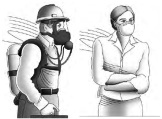
OSHA Breathes Life into Respirator Selection Guidance
OSHA has published "Assigned Protection Factors for the Revised Respiratory Protection Standard," a new guidance document designed to provide employers with vital information for selecting respirators for employees exposed to contaminants in the air. APFs concern the workplace level of respiratory protection that a respirator or class of respirators is able to provide to workers. OSHA revised its existing Respiratory Protection standard in 2006 to add APF and Maximum Use Concentration (MUC) provisions. The higher the APF number (5 to 10,000), the greater the level of protection provided to the user.
APFs are used to select the appropriate class of respirators that will provide the necessary level of protection against airborne contaminants. Such exposures can come from particles or a gas or vapor. MUC represents the limit at which the class of respirator is expected to provide protection. Whenever a hazard's exposure level exceeds the MUC, employers should select a respirator with a higher APF number. MUC means the maximum atmospheric concentration of a hazardous substance for which a worker can be expected to be protected when wearing a respirator.
"Proper respirator selection prevents exposure to hazardous contaminants and is an important component of an effective respiratory protection program," said Deputy Assistant Secretary of Labor for OSHA Donald G. Shalhoub. "This guidance document serves as another useful resource for protecting the health and safety of workers at risk for respiratory illnesses."
APF and MUC are mandatory respirator selection requirements that can be used only after respirators are properly selected and are used in compliance with the entire standard. The Respiratory Protection standard requires fit testing, medical evaluations, specific training, and proper respirator use. The standard applies to general industry, construction, longshoring, shipyard, and marine terminal workplaces. To access the new, 51-page guidance document, go to www.osha.gov/Publications/3352-APF-respirators.pdf.